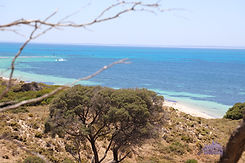
The Bickley Battery Project
A BIG SHOUTOUT to our awesome sponsor for his
support in this Rottnest Island Battery project!
Whilst he prefers to remain anonymous, he has this to say:
"With support from fellow urbexers and this one guy who used to crawl out of his bedroom window at 2 in the morning to explore the abandoned Victorian era birdhouse, East India Railway Hoteland any other manner of dusty abandoned buildings he could find as a kid.“
The site of the Bickley Battery, located at Bickley Point on Rottnest Island, was chosen with the intention that it would defend access to Gage Roads from the South Passage (p.2)
The Indian Ocean area, located just outside of Fremantle's North and South Moles is known as Gage Roads, stretching approximately 12.8km x 8km. Large vessels pass into or out of this shipping lane in order to access the Fremantle Harbour or remain anchored there until a berth becomes available.
Together with Oliver Hill Battery's 9.2-inch guns, Bickley's 6-inch guns would assist in counter bombardment tasks.
Now known as 'counter battery', counter bombardment is the "suppression of enemy batteries either by destruction or neutralisation" (p.6), preventing the enemy's ability to fire and reinforcements coming to their aid.
The Department of Defence acquired the land for the Bickley Battery site in July 1936 and construction begins on the main barracks at Bickley Point in October to house the personnel who'll be part of the units attached to the battery.
Planning the Bickley Battery
Although three 6-inch guns were initially considered (the third being a reserve), the final plan contracted out for construction consisted of:
-
two 6-inch guns (no's 2286 & 2290),
-
three magazines (one for each gun, as well as a reserve),
-
two gun shelters,
-
Battery Observation Post,
-
Close Defence Observation Post and
-
Artillery store.
According to the Aiming Post, the third gun was omitted from the final plan due to:
-
the limited space available in the area designated for the guns and Close Defence Observation Post (CDBOP)
-
there was a shortage of the long-range 6-inch guns and
-
provision of the facilities required for the gun's installation was impeded by the economic difficulties experienced at the time (p.2).
Building the Battery
Aside from water and sand being freely available on the island, all other construction materials were required to be transported using the Agnes and Duchess barges from the Fremantle Harbour (1).
Agnes - Little is known about the Western Australian State Shipping Service's wooden tug, which was used to salvage the Dutch RNN Submarine K-11 in 1946. The workboat was said to have been scuttled at Rottnest's ship graveyard (between 5 Fathom Bank and Stragglers Rocks) on 14 April 1955 but reports state that no trace of her have ever been found.
Duchess - Previously a privately owned wooden Swan River ferry steamer, it was converted into a barge. It was towed out to see in 1945 and scuttled.

Unidentified men unloading the first barge load of metal at Rottnest Island
Struggles at the Start
Both barges, described as being ancient, were able to offload all the transported materials using their own derricks (a crane with a pivoting arm). The island at the time lacked the facilities of such a hoist. The jetty itself was problematic and required upgrading, particularly in order to install a "heavy lift overhead hand-operated gantry" (2). The barrels of the 9.2-inch guns weighed approximately 30 tons, well over the limits of the lifting capabilities of the barges.
The original jetty, built in 1906, was upgraded in 1935. This saw it being extended by 47 feet and strengthened to accommodate the gantry.
This further facilitated the requirements for a railway network, connecting the jetty to the guns for each battery. There weren't even any roads on the island at the time, a task that was quickly made a high priority (3).
For approximately $33,200, the railway system was built, comprising of 10,000 jarrah sleepers, 15 turnouts (a configuration in the track which allows trains to move from one track to another) and 165 x 7.3m second hand rail, purchased from the West Australia Government Railways (4).
Two light diesel locomotives were transported to the island. One with its engine installed cross-wise was given the nickname 'Crab' whilst the other, 'The Crayfish' (4). A motorised trolley was also brought over for transporting up to six personnel at a time and this was used right up until the late 1950's by personnel who were tasked with maintaining the guns well after the batteries were put into 'care and storage'.
Whilst the batteries were being built, a shortage of drinking water was addressed with the construction of a bitumised catchment area in the vicinity of Mt Herschel, north on the island near Longreach Bay. It continues to be in use today at the Rottnest Island Desalination Plant.
All buildings that were deemed a reasonable size had their roofs used for water catchment, filling up their own freshwater tank or being diverted into nearby reservoirs (6).

View of camouflage on main water tank on Mount Herschel, Rottnest
References
1. The Coast Defences of Western Australia 1826-1963: A Study by R. K. Glyde for personal use (Printed 1991), p.83
2. ibid, p.84
3. Oliver Hill Battery Rottnest Island: Conservation Management Plan. Completed on behalf of the Rottnest Island Authority by Palassis Architects (December 2005), p.9
4. ibid, p.84
5. ibid, p.84
6. ibid, p.85
.png)

